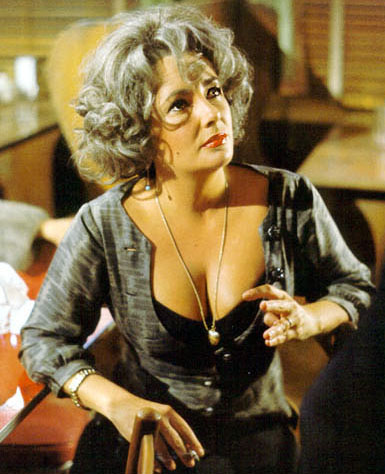hilanthropic, violet-eyed beauty Elizabeth Taylor is receiving the Screen Actors Guild’s Lifetime Achievement Award on Sunday. Surely mentioned during her accolades will be such unforgettable classics as Lassie Come Home, National Velvet, Little Women, Father of the Bride, Cat on a Hot Tin Roof, Cleopatra and Who’s Afraid of Virginia Woolf?
But there’s a whole series of relatively obscure movies that Taylor made in Europe during her turbulent affair with Richard Burton that are mostly forgotten… or not talked about. Taylor met Burton on the set of Cleopatra in 1963, and the two entered a tempestuous, on again/off again relationship that lasted until his death in 1984. During their (first) marriage in the late ’60s and early ’70s, the couple had a contract rider which provided that neither could work more than an hour away from the other, so while Burton was off shooting Where Eagles Dare, Raid on Rommel and Bluebeard at locations across Europe, Taylor starred in a series of campy, hair-pulling, teeth-gnashing, hand-wringing, shouting matches that you won’t find in just any Blockbuster. I call them her messy-hair movies.
The common thread is that she was wild-haired, garishly made-up, flamboyantly dressed, highly sexed and uncharacteristically zaftig in these movies. They defied what the world loved in Liz, and today they are relegated to the bargain bins of video stores and late-night television, but they warrant attention.
After a generation as a wholesome child star, then another as a glamorous sex symbol, Taylor disregarded everyone’s advice and, at 32, shattered her image by playing a lumpy shrew of a 50-year-old alcoholic opposite Burton in Mike Nichols‘ taboo-breaking Who’s Afraid of Virginia Woolf?
In her book Elizabeth Takes Off, Taylor recounts how she bulked up on fried chicken, mashed potatoes and gravy, sundaes and malteds for the role of Martha. Then for filming, they stuck prosthetic devices under her eyes and chin to complete the illusion. The gamble paid off; Taylor took home a well-earned Best Actress Oscar and was for the first time considered an actress more than a movie star.
Then she moved to Europe where she reincarnated Martha in a series of forgotten films.
Secret Ceremony
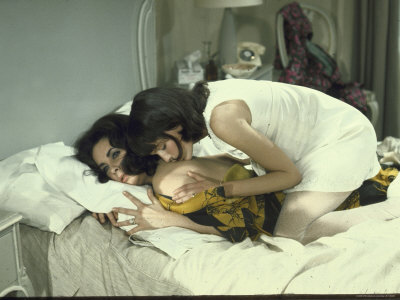
Mia Farrow attends to mummy dearest in Secret Ceremony.
The first film of note is Universal Pictures’ 1968 psychological melodrama Secret Ceremony, co-starring Mia Farrow and Robert Mitchum. This contemporary British gem — helmed by blacklisted filmmaker Joseph Losey, who last directed Taylor and Burton in Boom! — is distinguished by some, let’s say, Shakespearean-caliber overacting and dabbles in themes of mental illness, incest, lesbianism and pedophilia. It opens with Leonora (Taylor), a prostitute, removing a blonde wig and placing it upon the Blessed Virgin Mary on her mantle. She then shrouds herself in a black hood, not unlike Whistler’s Mother, and sets out to place some flowers on the grave of her 10-year-old daughter, who, we learn from the marker, drowned five years ago.
En route to the cemetery, Leonora is espied and followed by Cenci (Farrow), a weird, wild-eyed waïf in pre-Goth, beatnik, jet-black bangs and black leggings. Apparently, Leonora bears a remarkable resemblance to Cenci’s late mother, and the schizophrenic child-heiress entices Leonora back to the house in hopes of her moving in and “playing mother.” Leonora first resists, but when she sees the cavernous estate and the Marcos-like closets of furs at her disposal, she allows her maternal pangs to take over and assumes the role of “Mummy.”
Lines are soon blurred between child and parent in some suggestive scenes between Taylor and Farrow in the bath tub and in the bed before Cenci’s perverted American stepfather (Mitchum) returns from the States to shake things up even more.
The most amusing line in the movie comes when Cenci’s meddlesome spinster aunts, who were apparently cut out of the will, inform Leonora that Cenci is 24 years old. “Crazy people never look their age,” the inimitable Dame Peggy Ashcroft quips. “I’d always been busty, but in movies like Secret Ceremony I was getting tubby,” Taylor writes in Elizabeth Takes Off. “I honestly think it was from all that blissful living I was doing with Richard, who, by the way, didn’t put on a bit of weight even though he indulged himself, too. What larks we had, but we tried not to let our fun interfere with our professional lives. Our credo might have been ‘Eat, drink and be merry, for tomorrow we report to work.’”
Taylor again shatters her glamour girl image in Secret Ceremony by belching bovinely over a perfectly civilized spot of tea. She flounces around the mansion in fabulous Dior chiffon gowns and hairpieces by Alexandre. “You look more like a cow than my late wife,” huffs Mitchum, when he confronts the evasive Leonora on the beach. Taylor’s role in Secret Ceremony was originally intended for Ingrid Bergman, and I wonder if that line would have been included if Bergman were Leonora.
Losey (A Doll’s House) surely had his hands full on this picture. Twenty-two-year-old Mia Farrow was red-hot with the success of Rosemary’s Baby, but her marriage to Frank Sinatra was ending, cruelly, and Taylor took her under her wing when the production had to be temporarily shut down. Meanwhile, during the shoot, Taylor and Burton circumvented British quarantine laws that required imported dogs to be isolated for six months by anchoring their yacht, Kalizma, in the middle of the Thames. It turned into a media circus around the Burtons’ floating dog kennel, and Losey was not amused.
X, Y & Zee
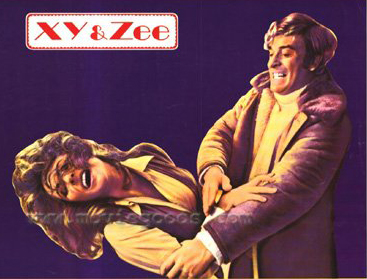
Elizabeth Taylor gets what she wants from Michael Caine in X, Y & Zee.
Again summoning the spirit of that virago Martha, Taylor sparred with Michael Caine in 1972′s perfectly progressive and decadent X, Y & Zee, (known as Zee and Co. in Great Britain). This Golden Globe-nominated British take on Who’s Afraid of Virginia Woolf?, with rampant adultery and some shocking (for its time) lesbianism, is about feuding husband and wife, Robert and Zee Blakely, whose caustic love/hate relationship is jeopardized when he takes a young lover (Susannah York). The film also features distinguished, Tony Award-winning actress Margaret Leighton wearing champagne-colored afros and big, orange, Jackie O. sunglasses indoors.
With wild hair and Crayola eye makeup, Taylor resembles Divine at a fighting weight of nearly 200 pounds, and Robert alternately calls Zee a pig and a cow. Zee sprints around their groovy London flat concealing her tonnage beneath psychedelic caftans, muumuus and ponchos with scooped necklines and fringed cuffs. Oh, and there are hats, hats, hats, that would dwarf even Dolly Levi.
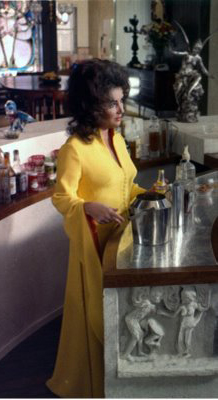 Sporting a headband with a gold coin in the middle of her forehead, Zee sits at a bar and commiserates with her dandy of a companion (“EastEnders”‘ Michael Cashman) who lilts, “Do it to him, darling. Have an affair with a gorgeous man.”
Sporting a headband with a gold coin in the middle of her forehead, Zee sits at a bar and commiserates with her dandy of a companion (“EastEnders”‘ Michael Cashman) who lilts, “Do it to him, darling. Have an affair with a gorgeous man.”
She retorts, “If your lot would stop increasing and multiplying, maybe there’d be somebody left to do it with.”
“There’s no need to get personal,” he sniffs, “or I shan’t do your hair nicely.”
Newly inspired, Zee allows her philandering husband to catch her getting suited up to go out at bedtime. As she taps on her riding hat, Robert asks, “Since when do people go riding in the middle of the bloody night?”
Zee chirps, “Some of my friends called to see if I’d like to go for a midnight ride. I assume they meant horseback riding… . Let me see if I’ve got everything.”
She cups her breasts, taps her thighs, then grabs her crotch in a move that likely inspired pal Michael Jackson‘s choreography a decade later. She gives a thumbs up and, with a giddyup click of her tongue, spins on her heel to leave. Robert, finally pushed too far, tosses her down on the bed and hog-ties her on the sheepskin bedspread in the film’s most renowned scene. Later, when they’re making up, she whispers, “No, don’t untie me.”
Ash Wednesday
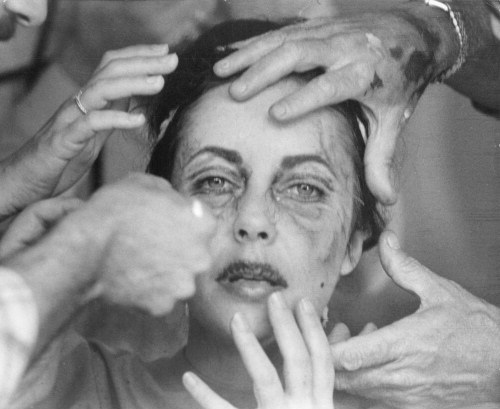
Taylor, at her worst, in Ash Wednesday.
Taylor looks her best and worst in this 1973 oddity from director Larry Peerce. Taylor plays a rich, overweight, prematurely wrinkled American housewife who, in a desperate attempt to save her marriage, jets to Switzerland for a facelift. Afterward, she recuperates at a ski resort and awaits her husband (Henry Fonda) while considering the advances of the young men who have now taken notice.
For the movie, Paramount Pictures hired Dr. Rodolphe Troques, who had done work on Burton the year before, to do an actual facelift on an Elizabeth Taylor-lookalike to be used in the movie. Snippets of the surgery were actually included in the film. During the shoot in Italy, Taylor’s face was insured for $1 million because of the extensive makeup work.
The Driver’s Seat
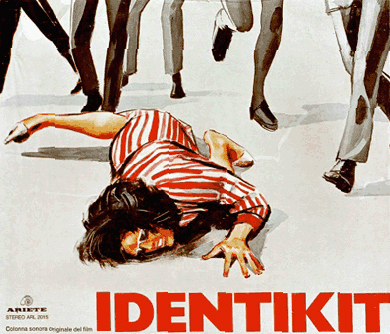
The German movie poster for The Driver's Seat.
Taylor’s pièce de résistance of her European oeuvre came in 1973 with the utterly incomprehensible and hallucinatory The Driver’s Seat, produced by Roberto Rossellini‘s nephew Franco, shot by Bertolucci’s Oscar-winning cinematographer Vittorio Storaro (The Last Emperor), and including a cameo appearance by Andy Warhol. Known as Identikit in Italy where it was filmed, and re-titled Psychotic for its videocassette release, The Driver’s Seat is another sexed-up, messy-hair role for Taylor.
It’s the story of Lise, a paranoiac German matron who purchases the gaudiest outfit imaginable — a polyester pink, green, yellow, orange and blue print Valentino monstrosity that she wears throughout the entire film — and embarks for Rome on some vague mission to find “the right man.” The first candidate is a handsome fellow on the airplane who flees to the front of the jet after she creeps him out with a hungry stare and a lusty tightening of her seat belt.
She does catch the attention of the man on the aisle who “looks like Red Riding Hood’s grandmother.”
“Do you want to eat me?” she flirts.
“I’d like to, I’d like to, but I’m on a macrobiotic diet and I can’t eat meat,” he concedes.
Next up is the enigmatic man she meets after a chaotic stampede at the airport. Andy Warhol returns a book she dropped in the melee, but he, too, is not her type.

Taylor in full make-up in The Driver's Seat.
Before the film is over, Lise has a brief masturbatory interlude in her hotel room, shoplifts a scarf from the department store where she abandons a sweet, little old Jehovah’s Witness (Mona Washbourne) in the toilet, and reluctantly fellates a Lathario of an auto mechanic in the front seat of his car.
Meanwhile, after every one of her bizarre encounters, the subjects are picked up by the police and brutally interrogated about their involvement with Lise, lending an air of mystery to the story.
The Driver’s Seat was made just after Taylor and Burton’s (first) breakup, and Elizabeth wasn’t even paid for her role. The producers simply had to pay the expenses for her $40,000-a-month, seven-room suite at the luxurious Grand Hotel. Still, she sustained herself with liquid lunches of Jack Daniels and lubricated herself on the set with Debauched Marys (“Five parts vodka, one part blood”).
Rosellini, who had produced Maria Callas in Medea, told Warhol, “People think that Callas was a prima donna, very difficult and insecure and demanding, but she was nothing, nothing at all, compared to Elizabeth Taylor. This woman will be the end of me, I tell you.”
Considering its credentials, the producers were peeved when The Driver’s Seat was turned down for the 1974 Cannes Film Festival in favor of Franco Zeffirelli‘s Brother Sun, Sister Moon, so Rossellini scheduled the world premiere of The Driver’s Seat on the Cote d’Azur the same night as Zeffirelli’s movie at the festival. Guests included Prince Rainier and Princess Grace, Aristotle Onassis, Ursula Andress and Taylor, which succeeded in drawing all attention from Cannes for the night.
After their divorce, Taylor returned to the States to make such films as A Little Night Music and The Mirror Crack’d. Oh, and “General Hospital” and The Flintstones. ![]()

